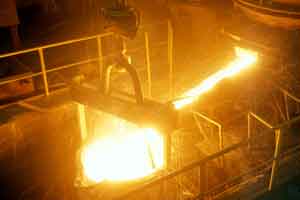Blast Furnace
In a blast furnace, iron ores are converted into liquid iron inside a large refractory-lined steel vessel. Raw materials (iron ore, coke, limestone), plus sintered products, are fed into the top of the furnace and very hot air is blown into the bottom.
The raw materials can take several hours to convert into molten iron and slag, and are drawn off periodically by drilling into a clay plug in the refractory lining and transferring to the next stage, via transportable ladles (torpedo cars). Hot dirty gases from the top of the blast furnace are cleaned and cooled to be used for burning in the hot stoves to heat the incoming "cold blast". The gases are injected into the bottom of the furnace by a number of tuyeres (large cast copper, water-cooled injectors), installed around the circumference of the blast furnace.
- At a Glance
- Featured Solutions
Determine temperatures in the stoves for controlling both stove heating and the heating of the cold blast. Temperature measurement is also required for the molten iron tap stream and to monitor refractory wear in the torpedo cars. Visual and temperature checking is required to avoid tuyere blockage.
- Repeatably measure the refractory temperature in each stove
- Monitor the sensor view visually from the control room
- Plan maintenance of torpedo cars and avoid costly damage
- Measure temperature tap stream from a safe distance
Other featured products
Get more information about Fluke Process Instruments solutions for this application





